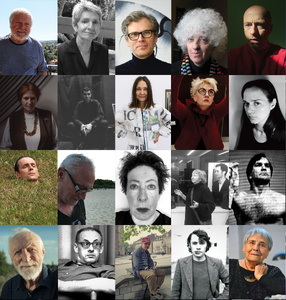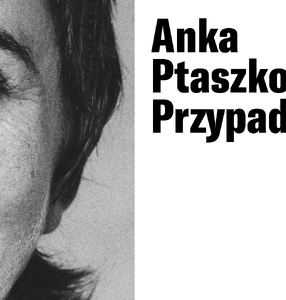Anka Ptaszkowska’s Archive documents the “art life” led by the critic, curator, gallerist and close collaborator of a dozen artists in Poland and France. It includes material dating back to the years 1956-2015. The Archive – curated by Maria Matuszkiewicz - is presented in the order given to it by Anka Ptaszkowska. It is selective by nature, responding to the interests and choices of its creator. The photographs, catalogues, letters and documents collected in it provide an insight into the ideas that were close to Ptaszkowska’s heart, show the intensity of her activities, the huge number of initiatives she undertook, her extensive international network of contacts and collaborators as well as the personal nature of many of her relationships. Ptaszkowska played a creative role in the art community, seeking independent ways for art to function, co-founding experimental institutions, writing manifestos and creating theoretical frameworks for art in action with artists, initiating meetings and bringing together people from different backgrounds and generations.
* * *
Anka Ptaszkowska was born in Warsaw on 17 December 1935. She is the daughter of Alina Mierzejewska and Stefan Ptaszkowski (who died in 1939 at the Battle of Wytyczno) and sister to Teresa. As a child, she lived in Zalesie Górne in a house built by her mother during the German occupation.
After secondary school, she studied history at the University of Warsaw from which she was expelled after one year (she refused to stand up during the singing of the “Internationale”). She graduated in art history from the Catholic University of Lublin and wrote her master’s thesis, a monograph on Tadeusz Kantor, under the supervision of Professor Jacek Woźniakowski. During her time at the Catholic University of Lublin, together with Jerzy Ludwiński and Włodzimierz Borowski, she was a member of the “Zamek” Group, one of the few independent artistic groups at the time, initially known as the Circle of Young Visual Artists. The group existed until 1960. Ptaszkowska published her first article “Classics or avant-garde?” (devoted to Henryk Stażewski) in the journal “Struktury” which was published by its members.
After graduating from university, she returned to Warsaw where together with Jerzy Ludwiński and Wiesław Borowski (also members of the Zamek Group), as well as Mariusz Tchorek, she became involved in the activities of Marian Bogusz’s Krzywe Koło Gallery. She worked at the University of Warsaw in the Polish Medieval Studies Group. In 1962, Ptaszkowska married Edward Krasiński and they moved into a house in Zalesie. This is where their daughter Paulina was born.
In 1966, together with critics Wiesław Borowski and Mariusz Tchorek, Ptaszkowska founded the Foksal Gallery in Warsaw, co-creating its programme and writing manifestos. She was friends with Henryk Stażewski and Maria Ewa Łunkiewicz-Rogoyska whose studio in Warsaw was one of the most important places for the art community in Warsaw. The house in Zalesie hosted frequent social gatherings, including the “Farewell to Spring” ball (June 1968), a controversial reaction of the community to the events of March 1968. At times against the convictions of those around her, she supported Krzysztof Niemczyk, a writer, painter and author of scandalous public space activities at the time, who was a social and artistic outlier. She worked closely and was friends with Tadeusz Kantor with whom she got into a deep dispute over the operating principles of the Foksal Gallery and the role of the critics who formed it. In 1970, as a result of the growing conflict within the Foksal Gallery, Anka Ptaszkowska and photographer Eustachy Kossakowski left for Paris. There she teamed up with the artist Daniel Buren and the critic Michel Claura and with their help established two experimental institutions in the 1970s. The first was a conceptual number gallery whose each successive manifestation - it could be an exhibition, a debate, a survey, an exhibition project or the sending of an invitation - was numbered consecutively from 1 to 36 (1972-1976). The gallery kept a wide network of contacts throughout Europe and the United States, was an important venue for conceptual and minimalist art in France and collaborated with artists such as Dan Graham, Carl Andre, Bernd Lohaus and the very interesting but lesser-known artists Hiroshi Yokoyama and Bertrand Wicquart. The Paris gallery also hosted exhibitions by Henryk Stażewski and Edward Krasiński and one of the galleries was devoted to Daniel Buren’s visit to Poland during which the artist made an intervention in the window of Henryk Stażewski’s Studio. The other institution was Vitrine pour l’Art Actuel (The Vitrine for Current Art 1977-1980), an alternative space housing a bookshop specialising in books by artists, a bar and a window space where galleries could advertise for a fee through a slide show. At Vitrine, Ptaszkowska met the artist André du Colombier whose work she consistently supported for many years, together with her friend and exhibition organiser François Guinochet. In the late 1970s and early 1980s, she organised an exchange between Polish and American artists which resulted in two collections: one devoted to American artists which was donated to the Museum of Art in Łódź and a collection of Polish artists donated to the Museum of Contemporary Art in Los Angeles. From 1980 to 2004, she taught modern art history at the School of Fine Arts in Caen where she organised seminars, exhibitions and events. Among former students with whom she has close ties and still collaborates today are the sculptor Rachel Poignant and Benoit Casas, founder of the publishing house NOUS. Other artists important to Ptaszkowska include the French artist Raymond Hains with whom she was friends and shared a sense of humour, and Koji Kamoji, a long-time friend and collaborator of the Foksal Gallery.
Curator: Maria Matuszkiewicz
Collaboration and coordination: Magdalena Drągowska, Malwina Gwiazdowska, Maciej Harland-Parzydło
We would like to thank all our volunteers and researchers for contributing their work to the Archive.


